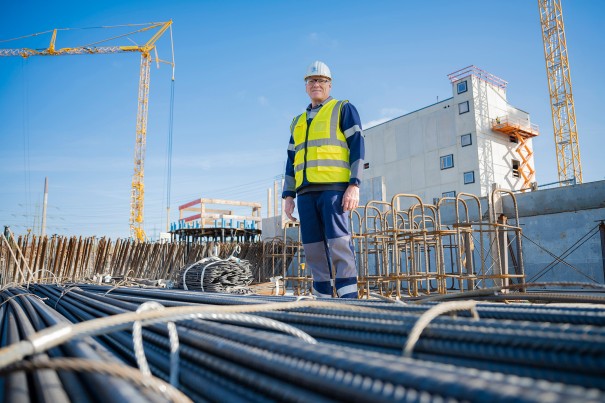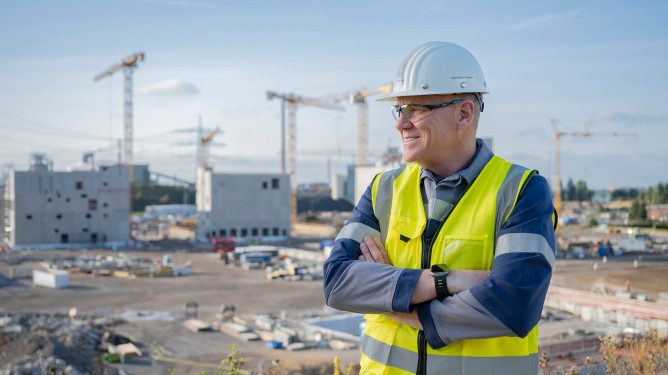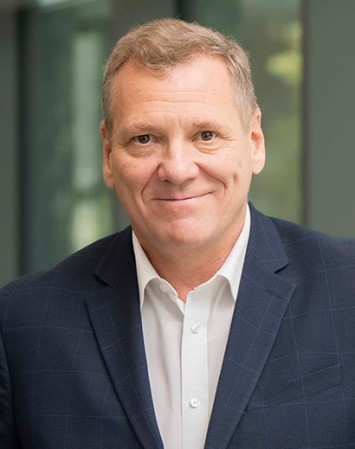Geht es da um die schiere Größe oder wo liegen die besonderen Herausforderungen?
Man muss sich vergegenwärtigen, dass wir hier allein von einem Baufeld sprechen, das so groß ist wie 40 Fußballfelder. Wir gehen davon aus, dass in Stoßzeiten künftig mehr als 2.000 Menschen auf der Baustelle in Duisburg sind. Da kann es immer mal wieder an der einen oder anderen Stelle haken. Dazu kommt, dass wir zahlreiche Anforderungen erfüllen müssen, um für ein solches Vorhaben die erforderlichen Bau- und Betriebsgenehmigungen zu erhalten. Das hat leider einige zusätzliche Monate benötigt.
Wie schwierig ist es, ein Bauprojekt dieser Dimension in den laufenden Hüttenverbund zu integrieren?
Die Realisierung auf dem Werksgelände in Duisburg stellt uns an verschiedenen Stellen vor höchste Anforderungen, etwa bei Planung, Logistik und Sicherheit. Die neue Direktreduktionsanlage muss schließlich nahtlos in bestehende Produktionsprozesse, Versorgungsleitungen und Infrastruktur eingebunden werden – das ist technisch hoch anspruchsvoll und erfordert präzise Abstimmung über alle Gewerke hinweg.

Wann glauben Sie kann es losgehen?
Ein festes Datum für den Start der DR-Anlage haben wir noch nicht festgelegt. Derzeit erfolgt eine entsprechende Überprüfung des Terminplans gemeinsam mit unserem Hauptlieferanten SMS, was bei Projekten dieser Größenordnung integraler Bestandteil des Projektmanagements ist. Wir gehen aber grob davon aus, dass die Arbeiten nach der Übernahme der Baustelle durch SMS im Oktober dieses Jahres noch ungefähr zwei weitere Jahre in Anspruch nehmen werden.
Bis dahin gab es bereits jede Menge zu tun. Wenn Sie als Projektleiter die Baustelle besuchen – welches Bild bietet sich Ihnen?
Die Baufläche war bis vor kurzem vor allem von enormen Mengen an Beton und Eisen geprägt, weil wir die benötigten Fundamente errichten mussten, bevor SMS mit dem Stahlbau und der Errichtung der eigentlichen Anlage beginnt. Für unser größtes Aggregat, den Direktreduktionsturm, der knapp 150 Meter hoch sein wird, wurde zum Beispiel eine bis zu drei Meter dicke, 40 mal 40 Meter große Betonplatte gegossen.
Wo kommt eigentlich das dafür benötigte Material her?
Das ist tatsächlich sehr interessant, weil die von uns benötigte Menge an Beton beispielsweise so groß ist, dass sich die Baufirmen ein mobiles Betonwerk am Rande des Areals gebaut haben, um sich zu versorgen. Gegossen werden draus etwa die Betonfundamente und die Bauteile für das fünfstöckige Haupt-Schalthaus.
Der Bau der Anlagen in Duisburg ist eines der weltweit größten industriellen Dekarbonisierungsprojekte und fällt in eine Zeit, wo Investitionen in nachhaltige Industrieanwendungen stark hinterfragt und öffentlich diskutiert werden. Zweifeln Sie selbst auch?
Nein, wir stehen unverändert zu unserem Bekenntnis zur grünen Transformation und zur klimaneutralen Stahlproduktion. An der Dekarbonisierung der CO2-intensiven Stahlproduktion führt langfristig kein Weg vorbei. Aber für langfristigen Erfolg sind wir auch darauf angewiesen, dass eine belastbare Wasserstoffwirtschaft entsteht, mit der sich diese Dekarbonisierung zu tragfähigen Kosten bewältigen lässt.
Können Sie das bitte erläutern?
Die Direktreduktionsanlage hat eine Produktionskapazität von 2,5 Millionen Tonnen direkt reduziertem Eisen pro Jahr. Dafür benötigt die Anlage im Wasserstoff-Vollbetrieb rund 143.000 Tonnen Wasserstoff pro Jahr. Der Strombedarf zur Herstellung dieser Wasserstoffmenge entspricht in etwa 60 Prozent des jährlichen Strombedarfs der Stadt Hamburg. Steht uns diese Menge Wasserstoff zu marktfähigen Preisen zur Verfügung, können auf diese Weise bereits bis zu 3,5 Millionen Tonnen CO2 pro Jahr eingespart werden – das sind knapp 20 Prozent unserer Gesamtemissionen.
Wie wird das gelingen?
Wir verharren nicht in Zweifeln, sondern gehen bei der Grünen Transformation weiter mutig voran. Als größter deutscher Wasserstoffverbraucher ist thyssenkrupp Steel Initiator und Treiber einer leistungsstarken Wasserstoffwirtschaft in Deutschland und bereitet so den Weg für die Dekarbonisierung der gesamten Stahlwertschöpfungskette. Wir halten an unserem Ziel fest, dass die Stahlproduktion bis 2045 vollständig klimaneutral sein soll.
Vielen Dank für das Gespräch, Herr Greiner Pachter!





